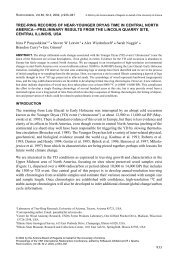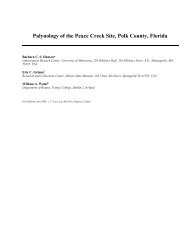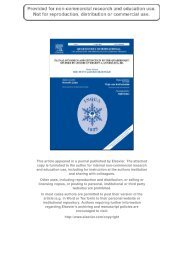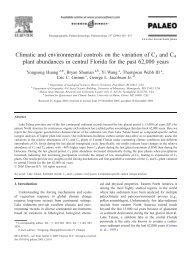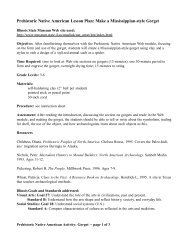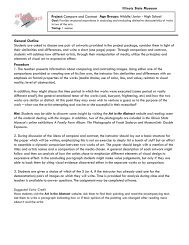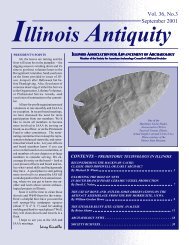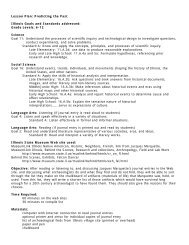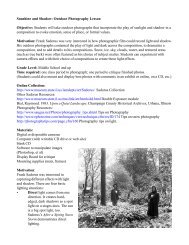1 - Illinois State Museum
1 - Illinois State Museum
1 - Illinois State Museum
You also want an ePaper? Increase the reach of your titles
YUMPU automatically turns print PDFs into web optimized ePapers that Google loves.
1. ВВЕДЕНИЕ<br />
1. INTRODUCTION<br />
П. М. Андерсон<br />
А. В. Ложкин<br />
Р. М. Anderson<br />
А. V. Loz/tkin<br />
Исследования четвертичного периода в Северной<br />
Азии имеют богатую историю. За последние 40 лет<br />
накоплено большое количество данных по окружающей<br />
среде прошлого. Этот регион играет важную роль при<br />
решении вопросов, связанных с изменением климата,<br />
прогнозом возможных будущих климатических флюктуаций,<br />
детального понимания региональных палеоклиматических<br />
явлений. Хотя к настоящему времени опубликовано<br />
несколько работ, рассматривающих изменение<br />
климата для обширных теf.риторий (например,<br />
[Tarasov et а!., 1996; Harrison et а ., 1996; Кremenetski et<br />
а!., 1998; Кhotinskiy, 1984], большая часть данных по<br />
Сибири и Российскому Дальнему Востоку остается собственностью<br />
отдельных лабораторий и недоступна в<br />
электронной форме. В связи с этим мы сделали первую<br />
попыт~ создать палинологическую базу данных, которая<br />
будет доступна международному научному сообществу.<br />
Мы сфокусировали внимание на палинологических<br />
данных , используемых для реконструкции палеоклиматов<br />
Северной Азии, занимающей территорию<br />
от 71 до 41° с.ш. и от 170° з.д. до 65° в.д. Приведеиные<br />
материалы не претендуют на абсолютную полноту. Например,<br />
мы не включили местонахождения, которые<br />
были ранее рассмотрены в Европейской или Глобальной<br />
базах данных и с которыми можно познакомиться,<br />
используя http: //www.ngdc.noaa.gov/paleo/epd.html или<br />
http://www.ngdc.noaa.gov/pa1eo/gpd.html.<br />
В первых двух разделах мы представляем основную<br />
информацию о регионе и данные о более широких географических<br />
рамках. Вводная часть также включает<br />
основную информацию, связанную с местонахождением,<br />
приведеиную в разд. 3-5. Местонахождения группируются<br />
по регионам: 1 - Северо-Восточная Сибирь<br />
(Чукотка, Яно-Индигиро-Колымская низменность, горные<br />
районы в верховьях Колымы и Индигирки, Северное<br />
Приохотье, рис. 1.1 ); 2- Западно-Сибирская равнина,<br />
рис. 1.2; 3 -Российский Дальний Восток ( Приморье,<br />
Нижний Амур, о. Сахалин и Курильские острова,<br />
рис. 1.3). Разделы по каждому региону включают введение,<br />
характеристику местонахождений и территорий,<br />
данные об изменениях позднечетвертичных климатов<br />
и растительности.<br />
Современная растительность. Северная Азия обладает<br />
значительным разнообразием растительных типов<br />
(рис. 1.4). На Дальнем Севе_ре, арктических островах<br />
господствует тундра с преобладанием травянистых<br />
сообществ (Роасеае, Cyperaceae, Artemisia sppJ. Кустарниковая<br />
rундра с Betula exilis, В. middendorjJ!_i, Alnus<br />
fruticosa, Sa!ix spp. и Ericales развита вдоль побережья<br />
арктических морей. Уникальная тундра с высокими<br />
кустарниками Alnus fruticosa и Pinus pumila характерна<br />
для ландшафтов центральной и южной Чукотки. Леса<br />
из Larix dahurica, включающие Betula sect. Albae,<br />
Populus suaveolens, Chosenia macrolepis доминируют на<br />
низменностях к востоку от Верхаянекого хребта, к югу<br />
до Охотского моря и к северу вдоль долины р. Колыма<br />
почти до побережья Восточно-Сибирского моря. Эти<br />
леса, названные светлохвойными, часто чередуются с<br />
редкостойными лесами и !'старниковой тундрой.<br />
Темнохвойный лес из Р1сеа obovata, Pinus sylvestris,<br />
Р. siblrica, Larix siblrica, Ables siblrica протягивается от<br />
западного побережья Охотского моря через всю Сибирь.<br />
Этот лес (тайга) подразделяется на северную, среднюю<br />
и южную субзоны. Основные деревья северных лесов<br />
Picea obovata, Larix siblrica, Pinus sylvestris, Betula sect.<br />
Quatemal)' research in northem Asia has а rich history,<br />
and а large Боdу of paleoenvironmental data has been<br />
amassed over tfie past four decades. Because of the<br />
importance of this region for questions related to past<br />
climatic trends and for predicting possiЬle future climatic<br />
scenarios, а detailed understanding of the regional<br />
paleoclimatic pattems and the data fi'om which they are<br />
шferred is v1tal. Although several continental-scale<br />
syntheses have been puЬlished (e.g., Tarasov et al., 1996;<br />
Harrison et al., 1996; Кremenetski et al., 1998; Кhotinskiy,<br />
1984), most of the paleoenvironmental data fi'om Siberщ<br />
and the Russian Far East remain in individuallaboratories<br />
and are unavailaЬle in electronic form. Consequently, we<br />
have made the first efforts in compiling а paГynological<br />
database that will Ье readily accessiЬle to the intematюnal<br />
science community. We focused on palynological data<br />
because they are the primary evidence used for reconstructing<br />
paleoclimates ofnorthem Asian. Here we define<br />
northem Asia as the area fi'om са. 71 о N to 41 о N and са.<br />
170° W to 65° Е. This compendium is not meant to Ье<br />
exhaustive. For example, we have not included sites that<br />
have been submitted previously to the European or Global<br />
Pollen Databases and mterested readers are urged to exj)lore<br />
these sources at h!fp://www.ngdc.noaa.gov/paleo/epd.html<br />
or http:/ /www.ngdc.noaa.gov/paleo/gpd.html.<br />
lfere and in chapter 2, we provide background<br />
information to help the reader place the region and tne data<br />
within а broader geographic and conceptual fi'amework.<br />
This introductory cfiapter also incluaes background<br />
information relevant for understanding the site descriptions<br />
given in chapters 3 through 5 .. The Sltes are organized Ьу<br />
region: 1 northeastem Siberia (Chukotka, the Kolyma-Yana<br />
InC!igirka lowlands, upper Kolyma region, upper Indigirka<br />
region, northem Priokhot'ye, Fig. 1.1); 2 the Westem<br />
SiЬerian Plain, Fig. 1.2; 3 the RusSlan Far East (Primorye,<br />
lower Amur valley, Sakhalin Island and the Kuril Islands,<br />
Fig. 1.3). Each geographic chapter is prefaced Ьх а general<br />
introduction to the area, followed Ьу а summary ofthe major<br />
changes in the late Quatemary vegetation and climate.<br />
Modern Vegetation. Northern Asia encompasses а<br />
great diversity of vegetation tyj)es (Fig 1.4 ). То the far<br />
north, arctic 1slands support heiЬ-domшated tundra (e.g.,<br />
Роасеае, Cyperaceae, lfrtemisia spp.). Deciduous shriib<br />
tundra, with Betula exilis, В. middenaorf]ii, Alnusfruticosa,<br />
Salix spp., and Ericales, is found along tKe coastal mainland.<br />
Unique high-shrub tundra of Alnui fruticosa and Pinus<br />
pumila characterizes the landscape of' central and southem<br />
Chukotka. Larix dahurica forest, which sometimes includes<br />
Betula sect. Albae, Popu!us suaveolens, and Chosenia<br />
macrolepis, is the dominant lowland vegetation fi'om east<br />
of the Verkhoyansk Range southward to the Okhotsk Sea<br />
and northward along the Kolyma valley nearly to the coast<br />
of the East Siberian Sea. The Russians refer to this<br />
vegetation as light coniferous forest, reflecting the limegreen<br />
color of Larix dahurica. The landscape is often а<br />
mosaic of open forests and shrub tundra.<br />
А dark coniferous forest with mixtures of Picea obovata,<br />
Pinus sylvestris, Р siblrica, Larix siblrica, and AЬies siblrica<br />
extends fi'om the westem coast of the Okhotsk Sea across<br />
Siberia. This forest or taiga is divided into northem, middle,<br />
and southem subzones. The main trees ofthe northem forest<br />
are Picea obovata, Larix siblrica, Betula sect. Albae, Pinus




